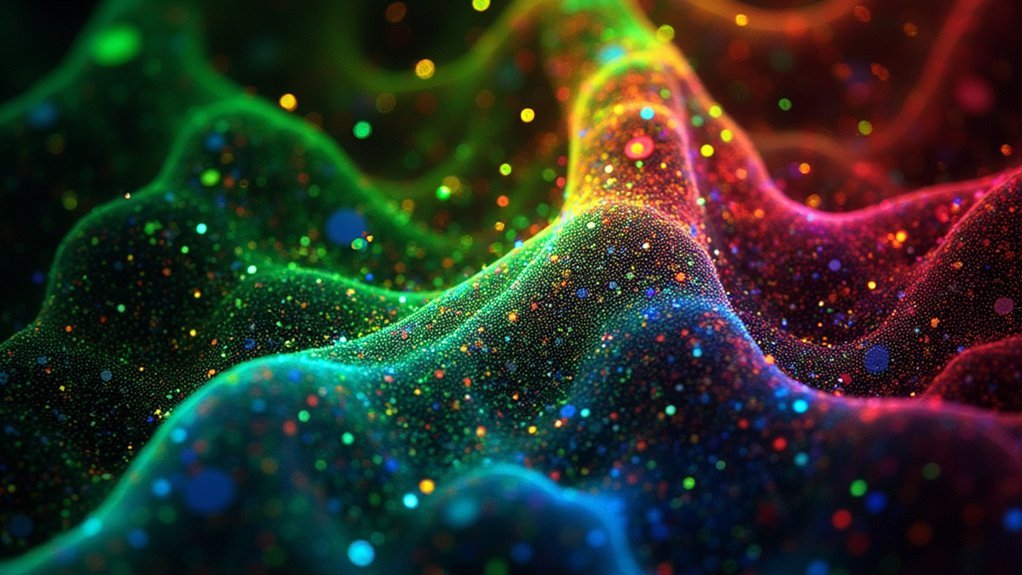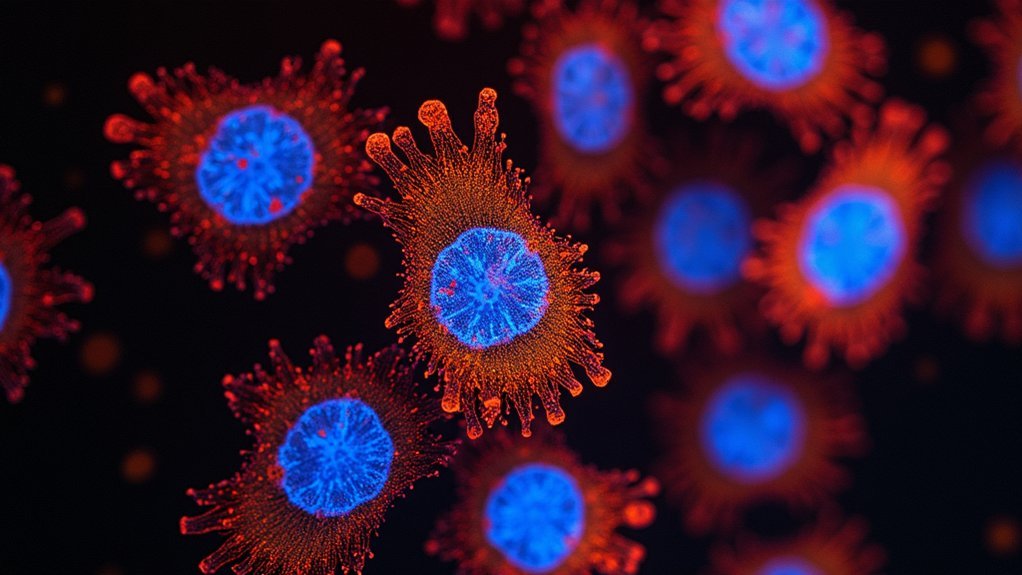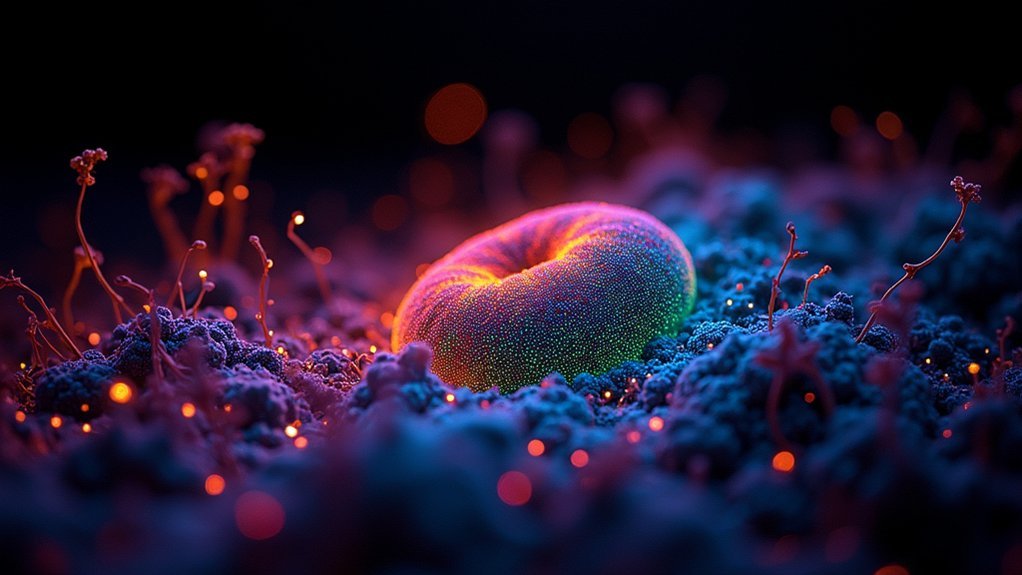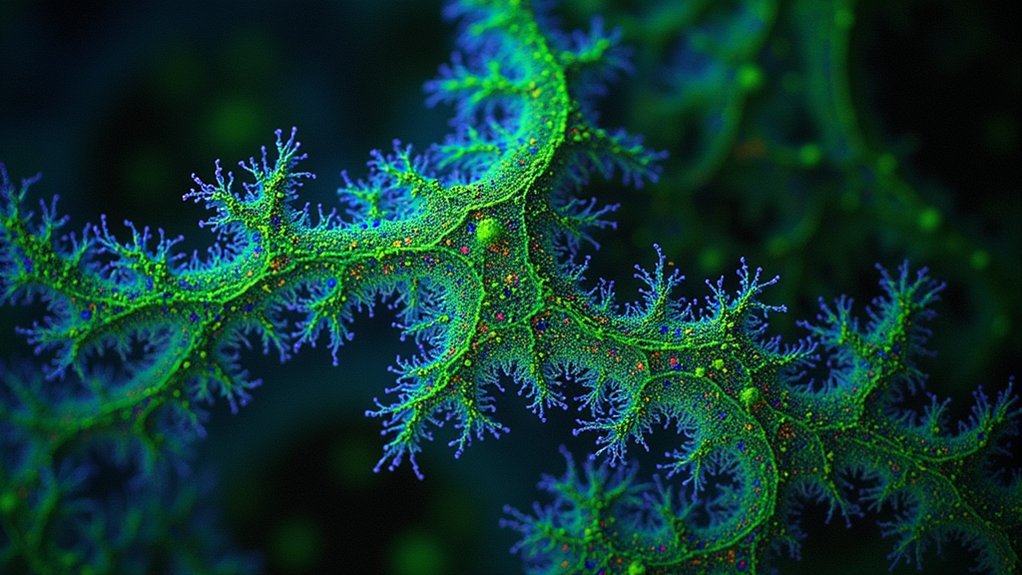Digital noise ruins your fluorescence images primarily through shot noise (following Poisson distribution), read noise from sensors, and background fluorescence masking valuable signals. Improper detector gain settings create misleading artifacts, while inappropriate laser power leads to photobleaching or insufficient detail capture. Depth-dependent signal loss and spherical aberrations further degrade image quality, especially beyond 100µm depth. Optimize your exposure times, implement proper background subtraction, and maintain consistent acquisition settings to transform your noisy images into clear, quantifiable data.
The Science Behind Digital Noise in Fluorescence Microscopy

When you capture fluorescence microscopy images, you’re inevitably confronted with digital noise that can compromise your results. This noise primarily stems from shot noise, which follows a Poisson distribution due to the limited photons available for detection.
Your imaging sensor contributes read noise, particularly in sCMOS technology, which can greatly impact image quality even though modern sensors achieve less than 1 electron of read noise. This becomes critical when working with faint signals.
Image quality can be significantly compromised by sensor read noise, even with advanced sCMOS technology’s sub-electron noise floor—especially when detecting weak fluorescence signals.
Background fluorescence, including autofluorescence from your specimen and optical components, further reduces contrast and lowers your signal-to-noise ratio. Combined with spherical aberrations and focus variations, these factors create a complex noise profile that obscures true fluorescence signals.
To combat these issues, you’ll need to optimize exposure times and laser power while maintaining consistent processing methods.
Common Sources of Image Noise in Fluorescence Imaging
Fluorescence microscopy suffers from several key noise sources that you’ll need to identify before implementing effective reduction strategies.
Shot noise emerges from the statistical nature of photon emissions and becomes particularly problematic at low light levels, directly impacting your signal-to-noise ratio.
Your detector choice matters greatly – electronic read noise from sensors varies with exposure time and gain settings, with modern sCMOS cameras offering improved performance over older technologies.
Don’t overlook background fluorescence and autofluorescence from your specimens, which can mask valuable signals.
Physical factors like spherical aberration and focus variations contribute to perceived noise, while inappropriate excitation intensity leads to photobleaching.
Balancing these competing factors requires careful optimization of your fluorescence microscopy setup to minimize noise while preserving biological information.
How Detector Gain Affects Your Image Quality

The critical relationship between detector gain and image quality represents one of the most important balancing acts in fluorescence microscopy. When you adjust your detector gain, you’re directly influencing your fluorescence signal’s amplification and consequently your image quality.
- Too low gain fails to capture subtle fluorescence details
- Too high gain introduces electronic noise, drastically reducing your signal-to-noise ratio
- High-gain settings can create misleading artifacts that mask true biological signals
- Inconsistent gain settings between imaging sessions make meaningful comparisons impossible
- Regular detector calibration guarantees peak performance and reliable results
Finding the sweet spot for your detector gain settings is essential for producing clean, interpretable images.
Remember that while gain can amplify weak signals, it simultaneously amplifies noise—making it vital to refine this parameter for your specific experimental conditions.
The Impact of Laser Power Settings on Signal-to-Noise Ratio
Selecting the right laser power setting represents a critical balancing act in fluorescence microscopy, much like walking a tightrope between visibility and sample integrity.
While increasing power boosts your signal from fluorophores and improves signal-to-noise ratio, you’ll quickly reach a point of diminishing returns.
Too much laser power triggers photobleaching and saturates your fluorophores, ultimately degrading your fluorescence images rather than enhancing them. Ironically, higher power also introduces additional background noise, counteracting the signal improvement you’re seeking.
The microscopy paradox: excessive laser power destroys what you’re trying to see while amplifying the noise you’re trying to avoid.
Conversely, insufficient power results in grainy images with poor signal detection. This delicate equilibrium directly affects the reliability of your quantitative measurements in arbitrary fluorescence units.
You’ll need to strategically adjust your settings for each sample to capture clear images without compromising cellular structures or molecular integrity.
Background Subtraction Techniques That Actually Work

While capturing the perfect fluorescence image requires ideal acquisition settings, effectively eliminating background noise demands equally thoughtful post-processing. Rolling ball background subtraction techniques can dramatically improve your signal-to-noise ratio by equalizing background levels across your images.
- Always share raw images before processing to facilitate troubleshooting and validation
- Normalize your signal-to-noise ratio consistently for accurate comparisons
- Maintain uniform acquisition conditions to guarantee background subtraction works effectively
- Consider deconvolution techniques as a powerful follow-up step using tools like Huygens or Fiji
- Monitor your instrument settings consistently as variations can undermine subtraction effectiveness
Remember that background subtraction isn’t just about removing noise—it’s about enhancing the true signal in your data while maintaining scientific integrity through transparent processing methods.
Optimizing Image Acquisition Parameters for Cleaner Results
Before diving into post-processing techniques, you’ll need to master the fundamental acquisition parameters that determine fluorescence image quality from the start.
Maintaining consistent exposure time and excitation light intensity is essential for minimizing variability in signal intensity across your imaging session.
To improve your signal to background ratio, focus on optimizing your image acquisition settings rather than relying solely on post-processing fixes.
Regularly monitor and reset your display range during acquisition to better visualize fluorescence signals against noise. This practice helps you make real-time adjustments to exposure settings for cleaner results.
Remember that superior initial image acquisition reduces your dependence on deconvolution techniques later, though tools like Huygens software can still enhance resolution in your 3D datasets when needed.
Deconvolution Methods to Enhance Image Clarity

You’ll find significant differences when comparing iterative vs. blind deconvolution algorithms, with each offering distinct trade-offs between processing speed and accuracy for fluorescence image enhancement.
To prevent common artifacts during deconvolution, you should carefully calibrate your point spread function and avoid over-iteration, which can create false structures or eliminate genuine signals.
Implementing appropriate regularization parameters tailored to your specific microscopy setup will further minimize edge ringing and noise amplification while preserving biological structures of interest.
Algorithmic Approaches Compared
Although researchers face numerous challenges with digital noise in fluorescence microscopy, deconvolution methods provide powerful solutions for enhancing image clarity.
When comparing algorithmic approaches, you’ll find significant differences in effectiveness and application:
- Huygens software and Fiji scripts implement deconvolution methods that reverse blurring effects while improving signal-to-noise ratio.
- Rolling ball background subtraction effectively removes background noise while preserving your true signal.
- 3D datasets benefit particularly from deconvolution, which restores lost resolution using the imaging system’s point spread function.
- Normalization techniques standardize background levels across images, enabling more accurate fluorescence intensity comparisons.
- DeepCAD-RT and similar advanced algorithms offer real-time noise suppression, allowing high-sensitivity imaging with minimal photon usage.
Artifact Prevention Strategies
While deconvolution algorithms can correct many image defects during post-processing, implementing proper artifact prevention strategies from the outset greatly improves your final image quality.
Consider incorporating Huygens software or Fiji scripts that employ deconvolution methods specifically designed to enhance the signal-to-noise ratio in your fluorescence microscopy datasets. Rolling ball background subtraction effectively normalizes background levels, reducing noise produced during acquisition.
For ideal results, maintain consistent acquisition conditions—steady excitation intensity and exposure times are essential for successful image processing.
When capturing fine structural details in biological samples, deconvolution can correct optical aberrations, considerably improving resolution and contrast. You’ll find that automated workflows incorporating these techniques not only streamline your analysis but also enable more accurate quantification across experimental conditions.
These preventative approaches minimize artifacts before they compromise your valuable data.
Practical Approaches to Normalize Signal-to-Noise Ratio
When comparing fluorescence images, you’ll need to normalize the signal-to-noise ratio using consistent background subtraction techniques like the rolling ball method.
You can further enhance image clarity through deconvolution using specialized software such as Huygens or Fiji scripts, which are particularly effective for 3D datasets.
To guarantee reliable results, maintain uniform acquisition and processing conditions across all images while routinely comparing raw data to identify potential noise issues.
Background Subtraction Techniques
Because fluorescence microscopy images often contain varying levels of background noise, effective background subtraction techniques are essential for reliable data analysis.
Rolling ball background subtraction can dramatically improve your signal-to-noise ratio by equalizing background across images, making fluorescence signals more distinct.
For ideal results when implementing background subtraction:
- Compare raw images before any processing to establish your baseline
- Apply background subtraction methods uniformly across all images to prevent biased quantification
- Consider image deconvolution, especially for 3D datasets, to further enhance clarity
- Normalize SNR between different images for accurate intensity comparisons
- Monitor acquisition conditions (light intensity, exposure time) to maintain consistent background levels
These techniques will help you extract meaningful data from your fluorescence images while minimizing the impact of digital noise on your analysis.
Deconvolution for Clarity
Although commonly overlooked by novice microscopists, deconvolution stands as one of the most powerful computational tools for enhancing fluorescence image clarity. By reversing blurring effects, deconvolution techniques like those in Huygens software dramatically improve your signal-to-noise ratio in fluorescence microscopy.
For ideal results, first apply rolling ball background subtraction to normalize background levels across your images. This preparatory step guarantees consistent comparisons between samples and maximizes deconvolution effectiveness.
When working with 3D datasets, deconvolution becomes even more essential, as it not only enhances visual clarity but also improves quantification accuracy of complex structures.
Don’t have expensive software? Accessible Fiji scripts offer cost-effective alternatives that can greatly enhance your fluorescence imaging results while maintaining scientific rigor in your experimental analysis.
Advanced Image Processing for Noise Reduction

While digital noise presents a significant challenge in fluorescence microscopy, advanced image processing techniques now offer powerful solutions to enhance image quality.
You’ll find significant improvements in your signal-to-noise ratio when implementing these methods:
- Rolling ball background subtraction normalizes SNR across images, ensuring reliable comparisons
- Image deconvolution software like Huygens dramatically improves clarity in complex 3D datasets
- Real-time noise suppression algorithms such as DeepCAD-RT enable high-quality imaging with minimal photon usage
- Consistent acquisition conditions and instrument setting monitoring reduce variability in image quality
- Denoising plugins provide efficient processing with reduced computation times
The Role of Spherical Aberration in Image Degradation
Spherical aberration caused by mismatched refractive indices between your sample and imaging medium will dramatically degrade fluorescence image quality.
You’ll notice depth-dependent signal loss as you image deeper into specimens, with fluorophores appearing dimmer and less distinct than their actual brightness would suggest.
These wavefront distortion effects create inconsistent focal planes across your field of view, making 3D reconstructions less reliable and introducing apparent noise that isn’t actually present in your biological sample.
Mismatched Refractive Indices
When light traverses media with different refractive indices during fluorescence microscopy, it creates spherical aberration—a significant source of perceived noise in your images. This optical distortion is particularly troublesome with high NA objectives, where light rays focus at different points, degrading your image quality.
- Mismatched refractive indices cause light to bend incorrectly, creating inconsistent ring sizes around fluorescent foci.
- Your image resolution suffers most at deeper focal planes where aberration effects compound.
- Immersion media selection directly impacts aberration severity—using the wrong oil can dramatically increase noise.
- Regular calibration prevents light from entering your lens at incorrect angles.
- 3D samples require special attention, as complex structures amplify aberration effects.
Monitor your axial focus depth consistently to minimize these effects and distinguish true signal from aberration-induced noise.
Depth-Dependent Signal Loss
The deeper you image into your sample, the more your fluorescence signal deteriorates—a direct consequence of spherical aberration’s compounding effects. When imaging through different refractive indices, light rays fail to converge at the same focal point, creating depth-dependent signal loss in your fluorescence images.
| Depth Effect | Impact on Imaging | Mitigation Strategy |
|---|---|---|
| Shallow (~10µm) | Minimal aberration | Standard calibration |
| Medium (~50µm) | Reduced intensity, blurring | Objective correction collar |
| Deep (>100µm) | Severe signal degradation | Adaptive optics, computational correction |
This phenomenon compromises quantitative measurements, making objects appear dimmer and larger than they actually are. As imaging depth increases, the aberration worsens exponentially, distorting both spatial information and fluorescence intensity. Proper calibration of your optical system becomes essential when acquiring images across varying depths.
Wavefront Distortion Effects
As light travels through your optical system, its wavefront becomes distorted by spherical aberration, fundamentally altering how fluorescence signals appear in your final image.
This optical distortion affects both resolution and accuracy, particularly when you’re using high numerical aperture configurations.
- Spherical aberration causes light rays to focus at different points, blurring your images.
- Ring-shaped fluorescence signals appear inconsistent in size and shape.
- High numerical aperture settings, while providing better resolution, amplify aberration effects.
- Variations in focus depth with oil immersion lenses worsen the problem.
- Proper compensation requires precise optical adjustments to maintain high signal-to-noise ratios.
When these distortions go uncorrected, your carefully designed experiments can yield misleading results.
The subtlety of spherical aberration means you mightn’t immediately recognize its effects, yet it’s consistently degrading your imaging performance.
Real-Time Denoising Technologies for Live Cell Imaging
Recent advances in self-supervised deep learning have revolutionized how we process fluorescence microscopy data with remarkable speed and efficiency. Technologies like DeepCAD-RT deliver real-time denoising capabilities that dramatically enhance image quality while requiring tenfold fewer photons than traditional methods.
You’ll notice a significant difference in signal-to-noise ratio when implementing these tools, as they can process images 20 times faster while reducing network parameters by 94%. This breakthrough makes live cell imaging more effective, especially when tracking rapid biological dynamics such as calcium signaling or neutrophil migration.
What makes these technologies particularly valuable is their ability to function at peak performance even in low-SNR conditions without compromising detail. By using augmented training data, they eliminate overfitting issues, revealing cellular features that would otherwise remain hidden in noisy images.
Quantitative Analysis: Preserving Data Integrity During Noise Reduction
Preserving data integrity while reducing noise presents one of the most critical challenges in quantitative fluorescence analysis. When you’re working with fluorescence data, maintaining consistent signal-to-noise ratios across images guarantees your comparative analyses remain valid.
Signal integrity in fluorescence analysis demands consistent noise reduction protocols to ensure quantitative comparisons remain scientifically valid.
Proper processing techniques can greatly improve your results without compromising data fidelity.
To maintain data integrity during noise reduction:
- Apply uniform background subtraction methods like rolling ball algorithms across all images
- Normalize signal-to-noise ratios systematically between different acquisition sessions
- Implement consistent processing protocols to avoid introducing bias in measurements
- Use advanced deconvolution algorithms (like those in Huygens or Fiji) to enhance clarity
- Monitor acquisition parameters carefully, including exposure time and excitation intensity
Remember that inconsistencies in your processing workflow can distort quantitative measurements more than the noise you’re trying to eliminate.
Best Practices for Consistent High-Quality Fluorescence Imaging
While digital noise remains inevitable in fluorescence microscopy, consistent high-quality imaging depends on disciplined acquisition and processing workflows.
You’ll need to maintain uniform acquisition settings across imaging sessions, controlling excitation intensity and exposure times to guarantee comparable results.
Implement techniques like rolling ball background subtraction and deconvolution to enhance your signal-to-noise ratio. Proper normalization of intensity values is critical when comparing different images, as variations can stem from both technical factors and biological differences.
Adhere to standardized protocols throughout your workflow—from sample preparation to image processing. Regularly monitor instrument performance and recalibrate when necessary.
When noise persists, don’t hesitate to retake images under controlled conditions, accounting for photobleaching and potential artifacts that might compromise your data’s quality and reliability.
Frequently Asked Questions
How Does Noise Affect Image Quality?
Noise reduces your image’s clarity by creating halos around foci, decreasing contrast, and distorting signal interpretation. It’s especially problematic in low light conditions where it obscures true biological signals you’re trying to capture.
What Is the Noise in Fluorescence Microscopy?
In fluorescence microscopy, noise comes from electronic sources, photon shot noise, and background fluorescence. You’ll see this interference as grainy patterns or random variations that limit your ability to detect faint signals clearly.
What Are the Disadvantages of Fluorescence Imaging?
You’ll face limited light sensitivity, photobleaching of fluorophores, autofluorescence background noise, potential photodamage to samples, high equipment costs, and technical complexity when using fluorescence imaging to visualize biological structures.
What Is a Disadvantage of Fluorescence Techniques?
You’ll face low signal levels in fluorescence techniques due to photon scarcity and photobleaching. Background noise, shot noise, and phototoxicity from high excitation light also compromise your image quality and quantification accuracy.
In Summary
Digital noise isn’t just an annoyance—it’s undermining your scientific data. By understanding detector mechanisms, optimizing your acquisition settings, and implementing appropriate processing techniques, you’ll dramatically improve your fluorescence images. Remember, there’s no single solution—you’ll need to balance signal strength against photobleaching and phototoxicity. Make these adjustments part of your imaging workflow, and you’ll consistently produce cleaner, more quantifiable results.





Leave a Reply